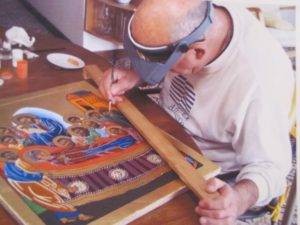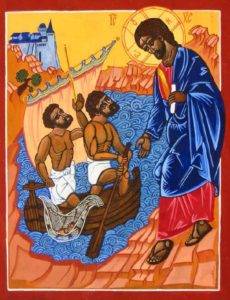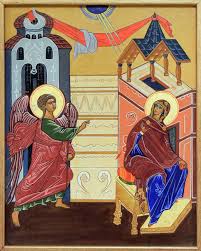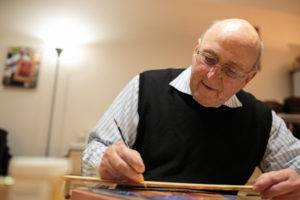The Art of Faith
 His artwork is admired by people all over the world. But Fr. Clyde Rausch, O.M.I. doesn’t paint icons for personal glory or the admiration of others. Instead, he paints for just one client. “God is my best customer,” said Fr. Clyde. “And I’m not even the painter, that’s the Holy Spirit.” Since the 1980s Fr. Clyde has been painting (often referred to as writing) icons that now grace churches, retreat houses, seminaries and other sacred places throughout Europe and the United States. He developed his artistic skills as a missionary priest in Sweden, and continues his work today in his studio at Oblate Renewal Center in San Antonio, Texas. Becoming an internationally–acclaimed iconographer was a ministry that Fr. Clyde never expected. In fact, he didn’t become serious about art until he was in his mid-40s. His previous painting experience involved walls, barns and some occasional sketching. Father Clyde was born in South Dakota and grew up on a farm. While in high school he began experiencing a calling to the priesthood and started corresponding with the Oblates who ran parishes about 20 miles away. Father Clyde said what first struck him about the Oblates was that they didn’t send him generic form letters. Instead, he received personal letters about his possible vocation.
His artwork is admired by people all over the world. But Fr. Clyde Rausch, O.M.I. doesn’t paint icons for personal glory or the admiration of others. Instead, he paints for just one client. “God is my best customer,” said Fr. Clyde. “And I’m not even the painter, that’s the Holy Spirit.” Since the 1980s Fr. Clyde has been painting (often referred to as writing) icons that now grace churches, retreat houses, seminaries and other sacred places throughout Europe and the United States. He developed his artistic skills as a missionary priest in Sweden, and continues his work today in his studio at Oblate Renewal Center in San Antonio, Texas. Becoming an internationally–acclaimed iconographer was a ministry that Fr. Clyde never expected. In fact, he didn’t become serious about art until he was in his mid-40s. His previous painting experience involved walls, barns and some occasional sketching. Father Clyde was born in South Dakota and grew up on a farm. While in high school he began experiencing a calling to the priesthood and started corresponding with the Oblates who ran parishes about 20 miles away. Father Clyde said what first struck him about the Oblates was that they didn’t send him generic form letters. Instead, he received personal letters about his possible vocation.
Those personal letters eventually led him to join the Oblate community and he was ordained in 1968.
 Father Clyde’s first assignment was looking like he would become a missionary in the Oblates newly-open missions in Brazil. But Fr. Clyde’s allergies and the hot tropical weather created second thoughts for his superiors. Instead of Brazil, he was sent to a much different new Oblate mission – Sweden. It would be his home for the next 29 years.
Father Clyde’s first assignment was looking like he would become a missionary in the Oblates newly-open missions in Brazil. But Fr. Clyde’s allergies and the hot tropical weather created second thoughts for his superiors. Instead of Brazil, he was sent to a much different new Oblate mission – Sweden. It would be his home for the next 29 years.
Much of Fr. Clyde’s time in Sweden was spent at a parish in the city of Taby near Stockholm. In addition to parish ministry, he also ministered at area hospitals and prisons. He found the people to be tough and resilient, like modern day Vikings.
For two years, Fr. Clyde ministered at an Oblate mission in the northern part of the country, just 100 miles from the Arctic Circle. At that time he met Oblate Bro. Olof Åsblom, an accomplished iconographer. Father Clyde found Bro. Olof’s serene religious icons fascinating, and especially appropriate for the quiet and reserved nature of the Swedes.
 With the help of Bro. Olof, Fr. Clyde began to develop his icon
With the help of Bro. Olof, Fr. Clyde began to develop his icon
painting skills. He discovered that an iconographer is not just a painter but also a writer, someone that tells a story through the artwork.
“It’s not something that you can just sit down and start to paint,” explains
Fr. Clyde. “You have to do your homework, read the Scripture, study and pray before you start. You have to create a relationship with the subject
you are going to paint.”
Sometimes Fr. Clyde can complete an icon in as little as a few weeks. Other icons can take years to finish. Father Clyde said a good iconographer can’t force the timeline. Occasionally he gets “writers’ block” and has to set an icon aside for several months. God will let him know when it’s time to restart.
 Father Clyde also explains that icons are not just representations of events
Father Clyde also explains that icons are not just representations of events
in the Bible. They are works of art full of symbolism. The people in the icons are painted looking serene, portrayed as saints in Heaven. Even the frame is symbolic, representing the border between Heaven (the picture) and earth (outside the frame). Frequently Fr. Clyde paints outside of the picture and onto the frame, showing the connection between present and past.
“The picture will pull you into it, or it will come out to you,” Fr. Clyde explains.
In addition to painting icons, Fr. Clyde also began teaching classes in the art form while in Sweden. Over the years he instructed hundreds of students to paint icons using their head and heart. The classes were truly
ecumenical as most of the students were not Catholic.
After 29 years in Sweden, Fr. Clyde was selected to represent the Oblates of Europe at their international headquarters in Rome. He served six years as the General Councilor for Europe. Then he served another six years as the treasurer for the Oblates’ worldwide congregation.
In 2013 Fr. Clyde’s tenure in Rome was over and he decided to return to the United States, finding a home with the Oblates in San Antonio. Most days he can be found in his studio working on icons or teaching the art form to students two days a week.
 When a person expresses interest in taking a class, Fr. Clyde never asks
When a person expresses interest in taking a class, Fr. Clyde never asks
them if they have any artistic talent. Instead, he chooses students who have a deep faith and want to express that faith to others.
“Jesus doesn’t pick us because of our talent, he picks us because he loves us,” said Fr. Clyde.
In Fr. Clyde’s classes, students use the same technique as iconographers from centuries earlier. No detail is too small, from the type of hair on the
brushes to the wood used for the icon. Father Clyde and his students also
make their own paint, through a combination of colored pigments, egg
yolk and water.
While the painting process might be precise, the actual artwork does not have to perfect. The lines can be crooked and the body parts don’t have to look exactly right. Father Clyde reminds his students to not sweat the details. If something doesn’t look right, or the spirit moves you in a different direction, just paint over the old and start something new.
Because of his reputation, Fr. Clyde routinely gets requests for commission work. But he turns most of the offers down. The few commissions he does accept are usually for a special purpose, like an icon depicting Mother Teresa with the Blessed Mother holding the infant Jesus that was commissioned by a St. Teresa of Calcutta Parish in Wisconsin.
“It’s hard to do commission work because I can’t paint within a timeframe,” said Fr. Clyde. “It gets finished when it gets finished.” So most of Fr. Clyde’s work ends up being donated to various Oblate ministries and other religious institutions. Several of Fr. Clyde’s works are prominently displayed within a few blocks of his studio, at Oblate School of Theology, Oblate Renewal Center and the recently completed Oblate Seminary Residences. He does sell all occasion cards of his work with the proceeds going to support the Oblates’ ministries in Tijuana, Mexico. While Fr. Clyde appreciates the acknowledgement of his artistic skills, he prefers people look past the picture and into the true meaning of the art. It’s not about painting; it’s about discovering a deeper understanding of one’s faith.
“This is my main form of prayer right now,” said Fr. Clyde. “When I go to the studio I don’t go there to paint, I go there to pray using a paintbrush.”
Published in the February 2019 issue of Oblate World – OMI USA.


